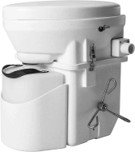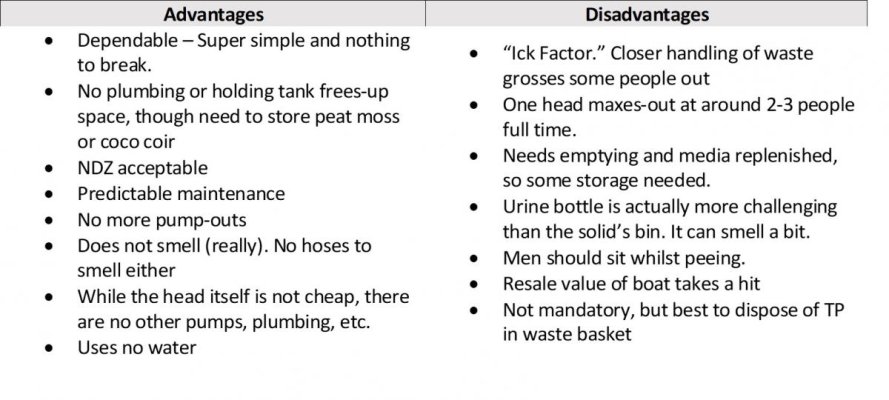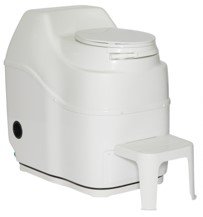mvweebles
Guru
- Joined
- Mar 21, 2019
- Messages
- 7,780
- Location
- United States
- Vessel Name
- Weebles
- Vessel Make
- 1970 Willard 36 Trawler
Compost Head – my experience so far.
Easily one of the most controversial decisions I made in my refit was to go with a Compost Head. I’ve been living with it for about a month and wanted to give feedback. Now, I realize these are not for everyone. Peggie Hall calls them a “Litter Box” with good reason: operating principles are similar though with one important difference: urine is separated from solid waste. I don’t write this to persuade anyone, certainly not to justify anything, just offer my experience and reasoning for going with a Compost Head (I chose the Natures Head HERE).

The principle behind a Compost Head.
First, “Compost Head” is a misnomer. They end product is desiccated but by no means composted, a process that can take months. The magic of a Compost Head is it has two compartments: Urine is diverted into a separate holding bottle and solid waste is deposited into a holding bin with a barely moistened media such as peat moss or coco coir. This is what separates a Compost Head from all other methods of waste management, including a litter box that develop an acrid, ammonia smell.
Why did I go compost?
When I was preparing to bring Weebles to Ensenada from San Francisco, my macerator pump died a couple days before departure. No problem, I bought a new one. It would run then immediately shut down. I was certain it was an install error – I tried reversing it, checking wires, maybe the breaker was bad. Everything. Spent many hours. And cleaned-up 3-4 times. Turns out the Macerator Pump was DOA – the overheat cut-off had malfunctioned.
But this was not my first head-related issue over 25-years. I thought about going a traditional head – the Elegance. But the more I thought about it, the more I realized it wasn’t just the head, it was everything connected to the head. When I was young I worked on a ranch and did my share of mucking so I was past the “Ick Factor.” It seemed like a Compost Head might work for me. I pinged CruisersForum asking for people who had one, would they do it again? About 50 unique answers from CH owners, and 100 or so hyperbolic responses from folks who were aghast at the idea (pretty sure at least a couple had some trauma during potty-training). Of the 50 owners, one was neutral, 49 were some version of enthusiastic “hell yea – never go back!” Then I started to realize how may threads there are on malfunctioning head systems and and how the stars must align for a joyful relationship with your head. I decided to give it a whirl. So far so good.
Usage
It’s important to keep moisture from the solids’ bin so men really should sit when peeing. Even though I make it a habit to sit when underway, it’s been a small adjustment. Afterwards, a couple sprits from a spray bottle with vinegar and water chases any residual urine into the bottle.
For solids, you open a fairly large trap door and let it fly. Close the trap door and rotate the churn a few times to bury the deposit and you’re done with that part. But…what about TP? While you could just put it in the solids’ bin, my guess is 99% of Compost Head users put it in a separate waste basket. Why? Without water and moisture, the paper will not really break down. While it’s not mandatory, I would say its recommended. Another learning-curve for me even though I’ve spent more time in Mexico than the US over the last 2-years.
Emptying and maintenance
With two people aboard, the urine bottle needs to be emptied every couple days. Now, I’m expecting someone to react negatively to this but I’ll say it anyway. I dump it overboard. Urine is almost entirely inert, though I’ll concede that while it’s legal to pee overboard, few people pee 2-gals at a time so maybe it makes a difference. Personally, I believe that if you’re not comfortable doing this, a Compost Head is too much trouble.
The solids bin is a bit more work. For a couple aboard, it needs to be emptied every 3-4 weeks. Amazingly, while it has an earthy smell, it is not objectionable. The biggest hassle is the lower half of the head has to be removed and inverted over a plastic bag. The bin is then re-charged with fresh media. Process takes about 15-20 minutes and needs to be done 12-15 times per year for full-timers, so compare to pump-outs. The contents are then deposited in the trash like dog poo; or could be dumped onto non-edible landscaping.
Closing
Clearly, this is a niche solution, especially for the TF crowd who are older, a bit more well-heeled, and with larger boats. It probably seems like camping and in a way I see the point. I’ve listed my best guess at Advantages/Disadvantages – some of the disadvantages are real deal-killers (Ick Factor). I think the ultimate setup for a 2-head boat is one compost, one traditional. As mentioned at the opening, I’m not going to pretend to persuade. Just offer my perspective.

Easily one of the most controversial decisions I made in my refit was to go with a Compost Head. I’ve been living with it for about a month and wanted to give feedback. Now, I realize these are not for everyone. Peggie Hall calls them a “Litter Box” with good reason: operating principles are similar though with one important difference: urine is separated from solid waste. I don’t write this to persuade anyone, certainly not to justify anything, just offer my experience and reasoning for going with a Compost Head (I chose the Natures Head HERE).

The principle behind a Compost Head.
First, “Compost Head” is a misnomer. They end product is desiccated but by no means composted, a process that can take months. The magic of a Compost Head is it has two compartments: Urine is diverted into a separate holding bottle and solid waste is deposited into a holding bin with a barely moistened media such as peat moss or coco coir. This is what separates a Compost Head from all other methods of waste management, including a litter box that develop an acrid, ammonia smell.
Why did I go compost?
When I was preparing to bring Weebles to Ensenada from San Francisco, my macerator pump died a couple days before departure. No problem, I bought a new one. It would run then immediately shut down. I was certain it was an install error – I tried reversing it, checking wires, maybe the breaker was bad. Everything. Spent many hours. And cleaned-up 3-4 times. Turns out the Macerator Pump was DOA – the overheat cut-off had malfunctioned.
But this was not my first head-related issue over 25-years. I thought about going a traditional head – the Elegance. But the more I thought about it, the more I realized it wasn’t just the head, it was everything connected to the head. When I was young I worked on a ranch and did my share of mucking so I was past the “Ick Factor.” It seemed like a Compost Head might work for me. I pinged CruisersForum asking for people who had one, would they do it again? About 50 unique answers from CH owners, and 100 or so hyperbolic responses from folks who were aghast at the idea (pretty sure at least a couple had some trauma during potty-training). Of the 50 owners, one was neutral, 49 were some version of enthusiastic “hell yea – never go back!” Then I started to realize how may threads there are on malfunctioning head systems and and how the stars must align for a joyful relationship with your head. I decided to give it a whirl. So far so good.
Usage
It’s important to keep moisture from the solids’ bin so men really should sit when peeing. Even though I make it a habit to sit when underway, it’s been a small adjustment. Afterwards, a couple sprits from a spray bottle with vinegar and water chases any residual urine into the bottle.
For solids, you open a fairly large trap door and let it fly. Close the trap door and rotate the churn a few times to bury the deposit and you’re done with that part. But…what about TP? While you could just put it in the solids’ bin, my guess is 99% of Compost Head users put it in a separate waste basket. Why? Without water and moisture, the paper will not really break down. While it’s not mandatory, I would say its recommended. Another learning-curve for me even though I’ve spent more time in Mexico than the US over the last 2-years.
Emptying and maintenance
With two people aboard, the urine bottle needs to be emptied every couple days. Now, I’m expecting someone to react negatively to this but I’ll say it anyway. I dump it overboard. Urine is almost entirely inert, though I’ll concede that while it’s legal to pee overboard, few people pee 2-gals at a time so maybe it makes a difference. Personally, I believe that if you’re not comfortable doing this, a Compost Head is too much trouble.
The solids bin is a bit more work. For a couple aboard, it needs to be emptied every 3-4 weeks. Amazingly, while it has an earthy smell, it is not objectionable. The biggest hassle is the lower half of the head has to be removed and inverted over a plastic bag. The bin is then re-charged with fresh media. Process takes about 15-20 minutes and needs to be done 12-15 times per year for full-timers, so compare to pump-outs. The contents are then deposited in the trash like dog poo; or could be dumped onto non-edible landscaping.
Closing
Clearly, this is a niche solution, especially for the TF crowd who are older, a bit more well-heeled, and with larger boats. It probably seems like camping and in a way I see the point. I’ve listed my best guess at Advantages/Disadvantages – some of the disadvantages are real deal-killers (Ick Factor). I think the ultimate setup for a 2-head boat is one compost, one traditional. As mentioned at the opening, I’m not going to pretend to persuade. Just offer my perspective.

Last edited:







